Llewellyn Publications's Blog, page 38
May 28, 2018
Refining Your Inner Game With The Eight of Swords Reversed
Readers, please enjoy this guest blog post by Leeza Robertson, author of Tarot Court Cards for Beginners and the new Tarot Reversals for Beginners.
The wind blew her hair like a directionless sail. Rain pelted down, cold and unforgiving on her thinly-clad body as she began to create a muddy bog beneath her bare feet. Forced to rely on her other senses, thanks to the blindfold, she becomes increasingly aware of the scents and smells the storm is creating around her. She knows that somewhere close by there are obstacles in her way, yet she senses that if she is careful, she could avoid them, maybe. She exhales one more time, allowing herself to take in all that is on offer to her before you she finally flips and jumps into the air. Hanging upside down just for a second or two, she suddenly realizes she has landed back in the exact same spot.
Such is the world of the Eight of Swords reversed. Just because you managed to claim some air time and momentarily stand on your head, doesn’t mean you have figured out why you are bound and rooted to the spot in the first place. There is a jolly good reason your old, go-to tricks are not working here and the longer you resist the more this situation will persist. Let’s go backwards for a moment and think about what came before this card. What did you reclaim or take in the Seven of Swords and how has it turned your world upside down here in the Eight of Swords? There are some unforeseen consequences playing out in this card and it might behoove you to stop, surrender, and take stock of what they are and what they mean.
In my new book Tarot Reversals for Beginners, I include five ways to read and interpret reversed (or upside down) cards. One of those ways is to think of your reversed card as if it is a mirror, where the image is a reflection, similar but not quite the same. Mirror aspects give us a chance to look at our current situation, problem or challenge in a different way. They allow us a chance to review all the information before us and find new ways of interpreting the data. So what is the data? What is being offered up for your review and reflection? Working intentionally with the Eight of Swords in reverse can benefit more than you know. Use the following spread to see what the Eight of Swords in reverse is reflecting back into your life at the moment and use the other cards in this spread as you data collectors.
This is a five-card spread where you will use the Eight of Swords reversed as your signifier. The four cards around it will show you all you need to know to use this topsy-turvy card to your advantage.

Card 1: Eight of Swords Rx
Card 2: Blessings. This card lets you know what blessings this reversed card brings to your current situation or problem. Take a moment to see what the world around you looks like; there will be a blessing for you to cling to like a life preserver. This is that card. Spend time with it and count how many times it shows up in your daily experience.
Card 3: Challenges. Remember when I told you that you might have brought some unexpected consequences with you from the Seven of Swords? Well, guess what? Here they are. Even a so-called “positive” card in this position is an unwanted complication to your current experience. Either deal with it or STOP giving it the attention it doesn’t deserve.
Card 4: Focus. This card shows you where your focus needs to be. This is where your head needs to show up and get in the game. Make sure your thoughts, spoken words and inner dialogue are in alignment with this card.
Card 5: Support. The universe never allows us to deal with anything by ourselves. Whether we know it or not we always have support, be it physical or vibrational, this card shows you exactly where your support currently is. It may not be what you want, but it is what you need in order to resolve or breakthrough this current situation or problem.
Our thanks to Leeza for her guest post! For more from Leeza Robertson, read her article, “Using Reversed Tarot Cards for Ritual and Spell Work.”
May 23, 2018
Hedgewitch Botanical Oracle
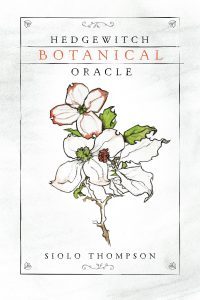
To see more, click
Welcome to the Hedgewith Botanical Oracle. This collection of 40 botanical cards draws inspiration from the grimoire of Hedgewitches – wise folks who walk the thin places between one world and another. These Healers, helpers, and shaman find the plants of their practice at the edges of cultivated fields as well as deep in the woods, wilds, and along shorelines. Each lovingly illustrated card includes an oracle property that can provide guidance to a seeker or meditative focus to a querent. Like these walkers between worlds, almost without exception the plants in this book are also living at the edges – the edges of disturbed lands with agricultural or industrial history, along hedgerows, roads, parks, and even in your own backyard. In most cases these are feral, rather than wild, the botanical histories of these plants is interwoven with our own for thousands of years in which they have been cultivated, disseminated, prized, ignored, treated as weeds, and ultimately spread to every corner of the earth.
The creation of this deck was inspired by Siolo’s own quest to become more knowledgeable about the plants around her and those at the root of a witch’s natural healing practice. Delving into the properties that tie these plants to divination and tarot has been a great process of discovery and delight. Each card in this series is lovingly illustrated in graphite, ink, and gouache and the accompanying book has information about the plant, its use and its properties as an oracle tool.
Here is an example:
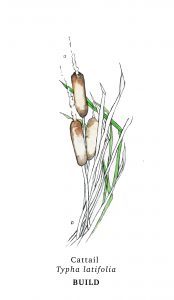
Cattail
Typha latifolia
Typha are a family of aquatic perennial plants with long graceful leaves and thick, sausage shaped rhizomes. When ripe, the heads disintegrate into a cottony fluff of seeds which are carried away by the wind. Many parts of the Typha plant are edible and useful to humans. The starchy heads can be harvested from late autumn to early spring and are nutritious when processed into a flour. They are fibrous though, so the starch must be scraped from the tough fibers. The heart of the outer portion of young plants once peeled, can be eaten raw or boiled and has an asparagus like flavor and is sometimes called Cossack Asparagus because of it’s popularity in parts of Russia. The leaf bases can be eaten raw or cooked, especially in late spring when they are young and tender. Even the pollen from the spring flower is edible and can be combined with egg, porridge, or soup as a thickener.
While this plant is a great potential foodsource it is much more widely used as a building material. The rushes and leaves are used to weave seating, roofing, insulation, boats, even whole floating islands upon which people build their houses! Animals like muskrats and beavers also use the rushes to build and insulate their homes. The oracle property BUILD is a perfect fit for this useful plant. There are times in life when we have to focus on immediate goals and concerns and there are times when we should be building, strengthening our foundations, and planning for the future. Relating this oracle card to tarot cards, one could connect it with the Ten of Cups or the Ten of Pentacles which both speak to building legacy, relationships, and the foundations of a strong home. If I were to create a Three of Wands card today I would definitely use cattails in the imagery because that card speaks strongly of planning for the future, looking ahead, and investing time and effort into personal development.
Other names: bullrush, reedman, reedmace, punks, corndog grass, Cossack asparagus
Oracle property: BUILD
May 16, 2018
Llewellyn’s 2018 Tarot Catalog Is Here!
We are proud to bring our readers our eighth annual tarot catalog! Discover the newest in tarot offerings from Llewellyn, Lo Scarabeo, and Blue Angel, plus get free shipping on US orders over $30 and 20% savings when you order online with the promo code found on the cover! Hurry, savings good through 8/1/18!
May 14, 2018
Happy New Moon in Taurus!
Readers, please enjoy this guest blog post by Danielle Blackwood, author of the new Twelve Faces of the Goddess.
 On May 15th, the Moon waxes new in the sign of Taurus. Although the Moon goes through all twelve signs each year, this particular Taurus New Moon is particularly potent, as just hours after the liminal moment of the New Moon (4:48 am PT, 7:48 am ET,) Uranus finally leaves AriesParadigm Shift: Five Practical Ways to Cultivate the Sacred Feminine as Uranus Enters Taurus“). This New Moon is doubly infused by the awakening, revolutionary energy of Uranus, as Mars enters the Uranus-associated sign of Aquarius the same day. Uranus/Aquarius is the Truthteller. The Changemaker. It is visionary, radical, progressive, and humanitarian, pushing boundaries and challenging the status quo. Its influence brings new ideas and needed change to the collective.
On May 15th, the Moon waxes new in the sign of Taurus. Although the Moon goes through all twelve signs each year, this particular Taurus New Moon is particularly potent, as just hours after the liminal moment of the New Moon (4:48 am PT, 7:48 am ET,) Uranus finally leaves AriesParadigm Shift: Five Practical Ways to Cultivate the Sacred Feminine as Uranus Enters Taurus“). This New Moon is doubly infused by the awakening, revolutionary energy of Uranus, as Mars enters the Uranus-associated sign of Aquarius the same day. Uranus/Aquarius is the Truthteller. The Changemaker. It is visionary, radical, progressive, and humanitarian, pushing boundaries and challenging the status quo. Its influence brings new ideas and needed change to the collective.
Taurus, on the other hand, is a very different archetype. Taurus tends to resist change. It wants to go slow, put down roots, and find its place under the sun, so it can blossom, and with patience bear fruit. Taurus is connected to tradition, the body, old world wisdom, resources, and sacred sensuality. It embraces hedonistic pleasure and the voluptuous enjoyment of earthly delights. This New Moon invites us to remember that we are embodied beings on the earthly plane. It asks us where we can best focus our intention toward cultivating, building, and manifesting something of true worth in our lives. It suggests ways we can take practical steps towards healing and building solid self worth. Every New Moon is an opportunity to plant seeds that we will nourish and bring to fruition over the next six months. It is a time to hit reset, and to begin anew in a particular area of our lives. To find out the life area that points to the most productive place to plant those seeds of intent for this New Moon, look to your chart to see what house contains 24 degrees of Taurus.
Taurus goddesses to tune in with for insight and support at this time include: Aphrodite Pandemos, Venus, Branwen, Gaia, Lakshmi, Flora, Hathor, and Annapurna.
For more ideas on working with Taurus on this New Moon, as well as all the other signs from a sacred feminine perspective, check out my book, Twelve Faces of the Goddess: Transform Your Life with Astrology, Magick and the Sacred Feminine.
Meditations/Journal Prompts for this New Moon in Taurus:
How can you implement powerful yet lasting change, mindfully, steadily, and with grace?
Where do you need to slow down, and remember to put one foot in front of the other?
Taurus is connected to the concept of right livelihood. Are you working in a way that makes sense to you from this perspective? What would you do differently if you knew you would thrive?
If you don’t feel that you are being paid fairly for the work you do, is it time to cultivate more self worth? Are you valuing yourself enough?
What are three ways you can bring more pleasure into your life in the next month? The next six months?
How can you bring creativity into your life in a practical hands-on way?
What does it look like when you feel calm and grounded? Where’s your happy place?
Our thanks to Danielle for her guest post! For more from Danielle Blackwood, read her article “Paradigm Shift: Five Practical Ways to Cultivate the Sacred Feminine as Uranus Enters Taurus.”
May 9, 2018
Lo Scarabeo’s Tarot Compendium
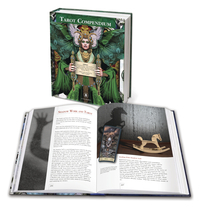
To see more, click here.
Tarot Compendium focuses on the esoteric workings that shape but more importantly power the meanings of the cards. As the introduction says, comparing exploring tarot to exploring a foreign city, “Esoteric information is like miles of electrical lines concealed under pavement. It is the water gushing through the buried pipes so large you walk through them with an elephant. It is the hidden network of tunnels speeding thousands of commuters over tracks to their station stops.”
While modern tarot approaches focus on the psychological, often at the expense of the esoteric, we should remember that “the evolution of esoteric Tarot and modern psychology both examine the same thing. They seek to examine and expand the inner life of the individual. Both practices dive into the deep space of the psyche, the places where personalities are formed, where behavior is created, where dreams are born—the palace from which an individual’s experience springs. Each modality reaches into darkness and obscurity to seek light and illumination. It is no coincidence that each unfolded next to the other. And it is no coincidence that many therapists, counselors, and psychologists find Tarot a useful tool for their personal and/or professional practice.”
Here is a tiny snippet about the exploration of the number 9 in tarot:
Number 9 is connected to six Tarot cards, two Majors [Hermit, Sun] and four Minors [the 9s of each suit]. The Hermit expresses the 9 as initiatory knowledge and the search for truth through meditation, solitude, and the ability to inhabit altered realities. The Sun is complimentary to the Hermit in the sense that it expresses sharing knowledge with others based on a dialogue leading to action. While the Hermit lights the journey with the lamp of knowledge, the Sun illuminates the entire world with its light.
The Minor Nines contain something about to occur, awareness of what is to happen, the origins and intentions that place the individual in a situation of knowledge. New forces are taking shape.
May 7, 2018
The Spiritual Side of Living a Cozy Life
Readers, please enjoy this guest blog post by Melissa Alvarez, author of Your Psychic Self, 365 Ways to Raise Your Frequecy, Animal Frequency, Believe and Receive, and the new Simplicity of Cozy.
 Living a cozy life is much more than just making your environment comfortable and warm, more than the materialistic, and more than rushing through the day just to get things done. It is much, much deeper and more powerful than the things that we do. The spiritual side of living a cozy life is when we allow our connection to our soul essence and our spiritual path to become a priority in the way we live, the way we interact with others, and in our beliefs. When you’re aware of your own spirituality and unique gifts, not only is your life cozier, but you spread that balanced feeling of lightness of being, of joy and happiness, and of being part of the world to everyone you meet, which will affect them in a positive way.
Living a cozy life is much more than just making your environment comfortable and warm, more than the materialistic, and more than rushing through the day just to get things done. It is much, much deeper and more powerful than the things that we do. The spiritual side of living a cozy life is when we allow our connection to our soul essence and our spiritual path to become a priority in the way we live, the way we interact with others, and in our beliefs. When you’re aware of your own spirituality and unique gifts, not only is your life cozier, but you spread that balanced feeling of lightness of being, of joy and happiness, and of being part of the world to everyone you meet, which will affect them in a positive way.
Our soul connection to the divine is what makes us unique and special. The way we think about our spirituality and our divinity usually comes from a place of warmth, love, and caring while seeking out deeper understanding of our divine selves. This foundation of loving warmth is also the building blocks of cozy living. It makes us more spiritually aware; urges us to seek out the cozy within our spirituality; and presses us to make changes to improve our lives, our surroundings, and the way we think so we can experience more coziness. This results in calmness, peace of mind, and positivity in everything we do. Once you’re aware of the ways coziness presents itself then you can acknowledge it and appreciate it, and through its discovery experience spiritual growth. Your spiritual self naturally wants to attune to the frequency of cozy because it is more harmonious and in sync with your divine being.
Once you recognize the benefits of cozy living, you’ll probably start making changes right away. Beginning with a clear vision will help you create a plan to add more coziness in your spiritual life, in your home and work environment, and in your relationships with others. Caring, compassion, selflessness, and love are all important aspects of the spiritual side of cozy living. When you embrace these feelings in regard to your spirituality, the way you relate to others, and how you want to experience a cozy life, you can bring about real transformations.
Our thanks to Melissa for her guest post! For more from Melissa Alvarez, read her article “5 Ways to Connect with the Simplicity of Cozy.”
April 18, 2018
Blending Core Meanings with Images
People wonder how to bring their readings to life. Those who focus on learning traditional meanings sometimes feel that their readings lack unity, depth, or just that certain something that makes them feel like more than a computer-generated interpretation. Those who focus intuition or reading the image alone can find that their readings lack focus, practicality, or structure making them feel like a collection of interesting observations but lacking in cohesion.
For me, blending both approaches allows the rational mind as well as the intuitive self to feel supported, allowing the natural strengths to shine and to fill in the blank areas each approach necessarily has.
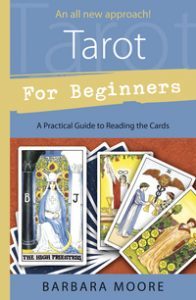
Because I believe this is a vital skill, my Tarot for Beginners focuses, in part, on showing how the same card from different decks all share a core meaning but illustrate or highlight different aspects. This analysis can also help prepare a beginner to read with confidence with almost any deck.
Here is an example of the 10 of Cups, using cards from the Rider Waite Smith, the Legacy of the Divine, and Shadowscapes tarots.
Ten of Cups
Core meaning: Happy home.
There are two cards that represent positive home or family lives: the Ten of Pentacles and the Ten of Cups. The former focuses on material stability. This one is about emotional stability and healthy relationships. The Ten of Cups shows the range of emotions found in a happy home: contentment, comfort, joy, playfulness, and affection. While these are generally considered positive, we should bear in mind that for some this scene is the very picture of boredom. Not everyone wants the same things.

The adults in the Rider Waite Smith card look skyward with arms upraised, acknowledging the role of the divine or spirituality in the their happiness. The children dance and play. The river in the card shows how their relationships flow through and nourish their lives.
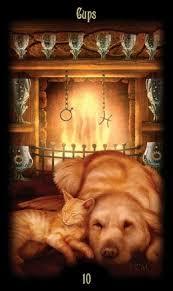
The Legacy card uses pets to illustrate the idea of unconditional love. This image focuses on warmth, comfort, and safety. The goblets represent the emotions and relationships upon which this experience is built. They shine and sparkle in the firelight, giving a remarkable beauty to an everyday scene.
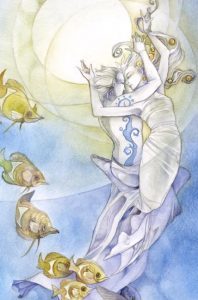
The Shadowscapes card focuses less on domestic bliss and more on a single, deeply emotional connection. The circle that encompasses the couple suggests safety and the joy of being in the world that they have created.
April 16, 2018
Congratulations to Our 2018 IPPY Award Winners!
Congratulations to our Llewellyn and Midnight Ink titles on their IPPY Awards!
Our 2018 winners are:
Magical Destinations of the Northeast , by Natalie Zaman (Silver; US Northeast, Best Regional Non-Fiction category)
Kitchen Table Tarot , by Melissa Cynova (Bronze; Best First Book – Non-Fiction category)
Uncorking a Lie , by Nadine Nettmann (Silver, Mystery/Cozy/Noir category)
Hollywood Homicide , by Kellye Garrett (Gold, Best First Book – Fiction)
The Independent Publisher Awards or IPPYs, are designed to bring increased recognition to the deserving but often unsung titles published by independent authors and publishers.
The 2017 Independent Publisher Awards (IPPYs) were revealed via an announcement on their website.
April 11, 2018
A Book for Every Pet this #NationalPetDay

For so many of us, our pets go beyond an animal presence in our lives; they are our children, extended members of our family who bring our soul love and nourishment while with is in this life and continue even after they’ve crossed the Rainbow Bridge.
To celebrate our pets this National Pet Day, I wanted to take a look at some of the books that we have that can help us strengthen our bonds with our fur-ever children.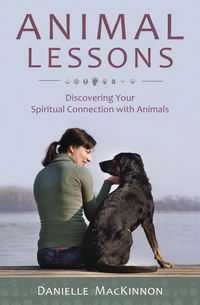 Animal Lessons, by Danielle MacKinnon
Animal Lessons, by Danielle MacKinnon
All around you, animals are acting as therapists, trainers, mentors, and gurus—if you pay attention. Each animal we encounter in our lives has a message for us, if only we listen (my fifteen-year-old cat Buckley, for instance, has peed on everything since the day I brought him home. I know that he chose me because he would have been surrendered by any other owner, and never had the chance to live into his super-senior years. But what is his lesson for me? I believe he’s been teaching me patience the last decade and a half…a LOT of patience.) Discover the lessons your animals are trying to teach you.
 Llewellyn’s Little Book of Spirit Animals, by Melissa Alvarez
Llewellyn’s Little Book of Spirit Animals, by Melissa Alvarez
Spirit animals can help you feel more balanced, peaceful, and confident in everything that you do. This convenient, hardcover reference book features more than 200 entries for wild, domestic, and mythical animals, allowing you to understand what each one symbolizes, how it may appear to you, and how to best use its guidance and energy. You’ll also find tips throughout the book and information on color and element meanings for each animal.
 The Little Book of Friends, by Heidi & David Cuschieri
The Little Book of Friends, by Heidi & David Cuschieri
Our pets never fail to bring a smile to our faces, whether through their antics or a gentle nudge when we’re feeling down. This book is filled with beautiful images of captivating creatures and inspirational words, and is sure to bring a smile to a special someone’s face each time they open it. The perfect gift for any occasion, or simply just because.
 Is Your Pet Psychic?, by Richard Webster
Is Your Pet Psychic?, by Richard Webster
I’m fairly certain that most (if not all) of us have wanted to communicate with our pets on a level deeper than cuddles and commands. All animals, both human and nonhuman, have the potential for psychic communication—why not develop it between you and your pet? But like any talent, psychic talent must be developed and practiced. Part collection of amazing animal stories, part psychic manual, Is Your Pet Psychic? is your guide to understanding and developing your pet’s psychic powers.
Bonus: Calling all cat lovers!
Coming this fall are some fabulous titles to help you bond with and celebrate your favorite felines.
 The Little Book of Cat Magic, by Deborah Blake
The Little Book of Cat Magic, by Deborah Blake
Deepen the bond between you and your cat as you weave magic together. This wonderful and witchy book is filled with a wide variety of spells, charms, and recipes that you can use to improve the lives of both you and your feline friends. From finding and naming a new cat to working with him as a familiar, The Little Book of Cat Magic has something for everyone who loves cats and magic.
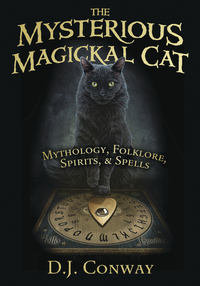 The Mysterious, Magical Cat, by D.J. Conway
The Mysterious, Magical Cat, by D.J. Conway
Bestselling author D. J. Conway offers a complete look at the feline family, from what it means when a cat flicks his tail at you to how you can use discarded whiskers in your magical workings. Discover the lore and origins of cats as well as how cultures have honored them throughout the ages. Explore fascinating details about cat anatomy and how to understand his behavior and verbal/non-verbal communication. Learn how to practice cat spells for healing, finding love, building courage, attracting prosperity, and much more.
Extra Bonus: Available in December
 Animal Healing, by Niki J. Senior
Animal Healing, by Niki J. Senior
It is always difficult to see our animal companions suffer with disease and illness. Providing in-depth descriptions and personal case studies about each healing modality, Niki J. Senior sheds light on the true nature of emotional animal health and disease. Using ground-breaking techniques and exercises, she shows you how gemstones, crystals, flower essences, and other natural remedies can effectively heal your animal.
Available for pre-order in the coming week!
April 4, 2018
More Than Upside Down
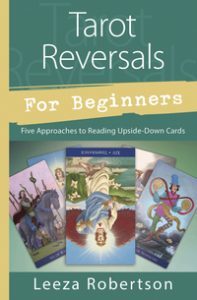
Whether or not to read reversed cards in a spread is a decision each reader must make for themselves. For those who choose to read reversals, they must then decide how to interpret the reversals. Most do not use the older methods, such as reading them as the opposite of the upright meaning or using a memorized traditional meaning (which often have nothing to do with either the upright meaning or the image). Instead, readers struggle to find a coherent method. Leeza Robertson focuses on five distinct aspects in her new book, Tarot Reversals for Beginners. Here is what she has to say:
When a card lands in your reading reversed, there is more going on here than just an upside down card. In many respects, this upside down or reversed card has some important information for you that goes far beyond the fact that it is the wrong way up. Just as there are many ways to read an upright card, there are numerous was to interpret an upside-down card. In this chapter we are going to explore 5 aspects of reversed cards. This will give you a larger framework to pull from when one of these stray cards wanders in to one of your readings or daily draws. These five aspects will set the tone for the rest of this book. In fact, each card you come across will have an explanation for one of the following aspects of a reversed card. You may find that one of these aspects speaks to you more than the others do in relation to your question. Or perhaps all 5 give you a larger view of both the problem and the solution. In many respects, you will use the information in this book on an intuitive level. You will know which aspect or aspects are right for the answer you seek.
The five aspects we will be exploring are as follows:
– Blocked
-Protection
– Mirror
– Shadow
-Retrograde
To the untrained eye the above list could just look like different words meaning the same thing. But the reality is the slight differences between them is vitally important. Understanding these differences is going to be your greatest tool for becoming comfortable and even confident with dealing with upside down cards.
Llewellyn Publications's Blog
- Llewellyn Publications's profile
- 243 followers



